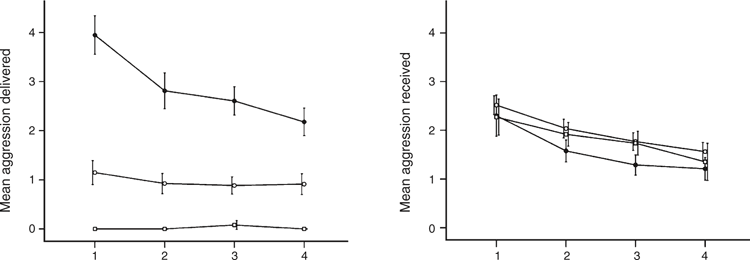Short and long-term repeatability of individual sow aggressiveness
M. Verdon A C , R. S. Morrison B and P. H. Hemsworth AA The University of Melbourne, Parkville, VIC 3010.
B Rivalea Rivalea (Australia), Corowa, NSW 2646.
C Corresponding author. Email: megan.verdon@unimelb.edu.au
Animal Production Science 55(12) 1512-1512 https://doi.org/10.1071/ANv55n12Ab055
Published: 11 November 2015
Published literature on the repeatability of individual sow aggression over multiple feeding bouts in a day or over the longer term does not exist, despite its implications for sow welfare (Verdon et al. 2015). This study tested the hypotheses that the aggressive behaviour of individual sows early after mixing into groups will (1) be consistent over multiple feeding bouts, and (2) be related to aggressive behaviour within the first gestation and (3) between the first and second gestations.
For the purpose of this paper, recently inseminated gilts were classified as sows. A total of 275 Landrace × Large-White sows was randomly mixed into uniform parity groups of 10 (1.8 m²/sow) within 7 days of insemination for their first and second gestations (200 sows per gestation with 126 sows observed in both gestations). Incidents of aggression delivered and received by individuals were observed for 30 min after four daily feeding bouts (0730, 0900, 1100, and 1500 h) at the day after mixing (d 2) and at d 9 and 51 of the first gestation, and at d 2 of the second gestation. At d 2 of the first gestation, sows were classified as ‘Submissive’ (SM) if they delivered little or no aggression, ‘Subdominant’ (SD) if they received more aggression than delivered, and ‘Dominant’ (D) if they delivered more aggression than received. At d 2 of both gestations, the aggression index for each sow [i.e., aggression delivered/(aggression delivered + aggression received)] was also calculated. An ANOVA for repeated measures examined the effects of SM, SD and D classification as well as the effects of feeding bout number on aggressive behaviour at d 2 of the first gestation. Data were square-root transformed prior to this analysis. The repeatability of the sow aggression index from d 2 to d 9 and 51 of the first gestation, and from d 2 of the first gestation to d 2 of the second gestation were tested using Spearman rank correlations (IBM SPSS, Version 17.0; USA).
The aggression index at d 2 of the first gestation correlated to that at d 9 (r = 0.69, n = 197, P < 0.001) and d 51 (r = 0.53, n = 137, P < 0.001) of the first gestation as well as to that at d 2 of the second gestation (r = 0.50, n = 125, P < 0.001). The between-gestation correlation was weaker than within-gestation relationships. Aggression delivered by SM and SD sows at d 2 of the first gestation was relatively constant regardless of feeding bout, but aggression delivered by D sows declined over subsequent bouts (classification × bout, F6,318 = 9.96, P < 0.01; Fig. 1). Consequently, aggression received by all sows reduced over the same period (F3,318 = 25.6, P < 0.001) although D sows received the least aggression (F2,106 = 5.5, P < 0.05; Fig. 1).

|
While genetics is likely to contribute to sow aggression, the reduced strength of the between-gestation correlation suggests that social experience and group composition may also influence the aggressive phenotype. Multiple bouts may provide SD and SM sows with increased opportunity to access food in later feeding bouts with reduced risk of aggression and injury, but will not prevent them from receiving aggression.
References
Verdon M, Hansen CF, Rault JL, Jongman E, Hansen LU, Plush K, Hemsworth PH (2015) Journal of Animal Science 93, 1999–2017.| Crossref | GoogleScholarGoogle Scholar |
Supported in part by Australian Pork Limited, Rivalea Australia and Pork CRC Limited Australia.


 ), Subdominant (
), Subdominant ( ) and Submissive (
) and Submissive ( ) sows over four feeding bouts (x axis) at day 2 post-mixing for the first gestation.
) sows over four feeding bouts (x axis) at day 2 post-mixing for the first gestation.